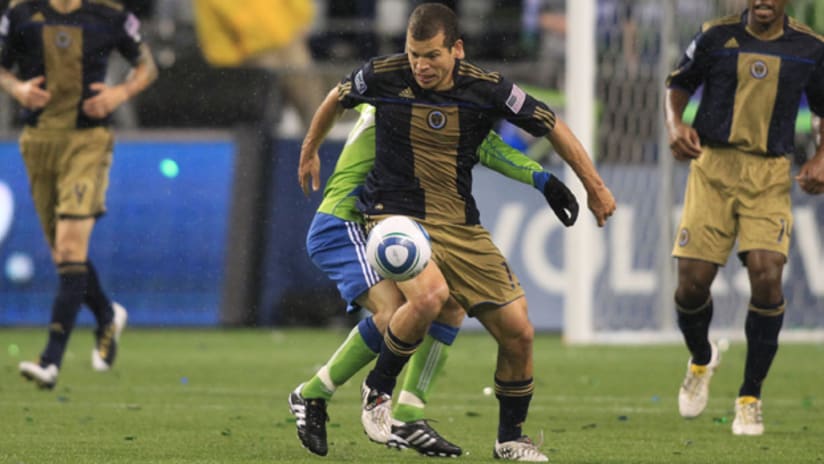The night belonged to Sébastien Le Toux. The industrious French attacker nailed his name in Philly sports history with a hat trick in the Philadelphia Union’s home debut, and the giddy supporters there will always show him brotherly love for it.
But will they remember Alejandro Moreno’s contributions?
Moreno spent the evening doing what a good target forward does: providing an outlet for his defenders and midfielders, holding up play while others join the attack, connecting with other attackers, taking some punishment in the process and, generally, just being a stinker for defenders to deal with.
Of course, a target forward can only be as good as what’s going on around him. That’s why the night at Lincoln Financial Field unfolded as such as great example of effective play off a target presence. Le Toux did more than supply the finishing highlights for the local news reels.
By maintaining close proximity to Moreno all night, “staying connected” in soccer parlance, Le Toux made Moreno’s job easier, constantly providing a handy option. Moreno could hold the ball momentarily or work something quickly with Le Toux.
Generally, if Le Toux hangs too close to Moreno, the target man’s job is more difficult because too many defenders are involved in the sequence too early. But Le Toux’s timing was impeccable: He prowled the periphery and then worked into the action at just the right moment.
On Le Toux’s second goal, Moreno’s play was classic stuff. (WATCH HERE.) The Venezuelan international sees that teammate Roger Torres needs an outlet coming out of defense under pressure. So he hustles back into Philadelphia’s half, holds off Brandon Barklage’s challenge, then supplies the best pass of the MLS weekend—a pinpoint ball in behind the D.C. defense.
In this case, Le Toux wasn’t so close to Moreno. But he recognized the space available and let his teammate know. Moreno’s wonderful, early pass tore through a back line still trying to organize.
Later, Moreno had a body on United center back Dejan Jakovic as a ball was flung out by the Philly defense. The pair got tangled, and Moreno might have been guilty of the first foul, but Jakovic sinned enough to earn a red card. Le Toux hit a free kick past a feeble wall and history was made.
The fact is, many target men like contact. Moreno sure does. He frequently initiates it, in fact. Instead of going directly toward a pass, they angle toward the defender and use their body to hold off their marker.
Other target forwards, like Seattle’s Fredy Montero, can be effective through less brawn but more technical proficiency. Montero is not a big body, but he’s got so much skill in those feet that he’s effective at hold-up play.
So Montero tries to ghost away from defenders. Several times Saturday against Real Salt Lake he separated from RSL center back Jámison Olave at the precise moment, then nimbly gained his balance to control the ball. The effectiveness of a target man like Montero is often attuned to the late-arriving pressure from the defender. Montero gets flak because he spends a lot of time on the ground. Does he embellish sometimes? Maybe. But no one can deny that he gets whacked a lot from behind. In other words, players are often on the ground for a good reason.
When’s Seattle’s offense doesn’t work, it’s sometimes because Montero’s relationship with Freddie Ljungberg is like a lot of families: It’s complicated.
When Ljungberg partners with Montero at forward he likes to float into the available space. But that means he’s roaming, often wandering out to the wings. Without Ljungberg close by, Montero has one less option. That’s why supporters in bars along 1st Ave. near Qwest Field always argue over Ljungberg’s best position—second striker behind Montero or out wide in midfield, as he played Saturday.
Moreno and Montero both want the ball at their feet. Others, not so much. Colorado’s Conor Casey is a bigger body, so he’s OK with balls delivered in the air. He’s also a different sort of target man in that he’s frequently looking to flick on those balls, directing them immediately somewhere else. (He does have Omar Cummings as a running partner, after all, which is a fine “somewhere else.”)
A guy like Montero usually wants to “absorb” the ball and then work with it, sometimes turning to take on defenders or finding Steve Zakuani darting into spaces on Seattle’s left side.
Casey has Colin Clark off his right shoulder (the Rapids’ left side) and now perhaps a healing Jamie Smith off his left shoulder as he works with his back to goal. So he has other options for redirecting those passes into him, spreading the play to two guys effective at working the flanks who can then serve balls back into the penalty area—which, presumably, is where Casey will be.
(Interestingly, Colorado’s opponent on Saturday plays a 4-3-3. Usually, an effective target man is a 4-3-3 staple. But Kansas City doesn’t really play that way. Kei Kamara can do the job but he’s often out on the right. Regardless, what the 2-0 Wizards are is doing is working.)
One to observe going forward is RSL’s Alvaro Saborio, who hasn’t established his place just yet at Rio Tinto but wears the look of a classy target player. He’s composed as he works back for the ball and has a good sense of what’s around him. The target man with a “snapshot” of his options as he moves to receive passes has half the work done.
Of course, in RSL’s late-show draw with Seattle, Saborio supplied the other element expected of any good target man: a goal.
Steve Davis writes about soccer for MLSSoccer.com, SI.com and his own blog, DailySoccerFix.com. His "Talking Tactics" column appears on MLSsoccer.com every Tuesday. He can be reached at BigTexSoccer@yahoo.com.













